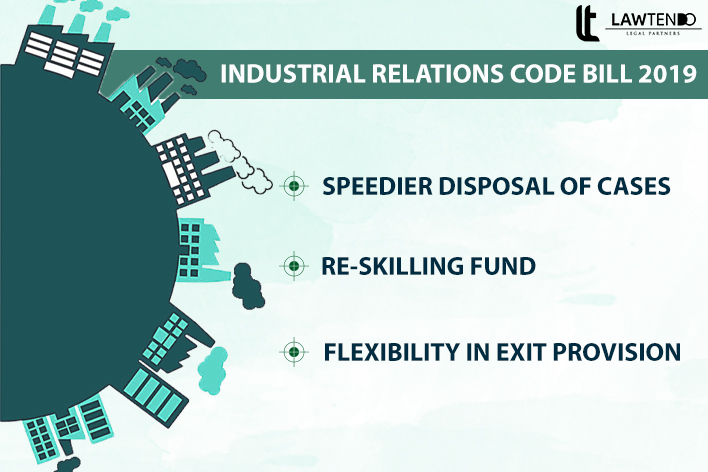Industrial Relations Code 2019 Decoded

Date : 06 Dec, 2019
Post By Adv. Jai Dixit
Introduced in Lok Sabha by the Labour & Employment Minister Santosh Kumar Gangwar, on Thursday i.e. 28 November 2019, Industrial Relations Code Bill, 2019 aims to smoothen the industrial relations while helping India promote the ease of doing business. Nature of employment in India has changed manifolds in recent and past years due to increased foreign investments, global trade, technological advancements, and others and increasing need to streamline the industrial laws surfaced as most important at this point in time. Keeping this need in mind, the IRC Bill 2019 was introduced. This Bill essentially combines important elements from three laws namely, The Industrial Dispute Act 1947, The Industrial Employment Act 1946 and The Trade Unions Act 1926. In this article, we shall understand the salient features of IRC Bill, and why worker groups are opposing the same. India has seen vast unemployment in recent years due to huge supply of work-force and it has now touched all-time high unemployment rate in 45 years. This is a step taken in favour of employees who become prey to unfair tactics and unjust practices prevalent in the organizations today due to trade unions. Many companies view these trade unions as threats and negotiating with them becomes too much of a pain. This bill shall solve such problem for the organizations as well. Salient Features of IRC Bill 2019 1. The IRC Bill allows an employer to engage and remove the workers based on the requirements of the project. This will make the process of hiring and firing easier for an employer and they can hire people and let go based on the requirements and demand in the market. 2. The bill has provisions for all statutory benefits such as; minimum wages, provident funds, medical benefits, social security and others and also promotes fixed-term employment of some duration across various sectors. 3. The bill retains the employee threshold at 100 allowing power to the government to reduce or increase the threshold through notification. This means that an employer can only lay off up to 100 employees without approvals. 4. The bill also advocates a provision for the re-skilling fund for the benefit of the employees who are being laid-off by the employers. 5. The bill introduces a special feature of ‘recognition of negotiating union’ according to which, a trade union can get the status of sole negotiating union if it has more than 75% workforce support. 6. The code forbids employees, workers, labourers, employers and trade unions from propagating any unfair labour practices listed in the Bill. These practices range from restricting the employees from forming trade unions, establishing employer sponsored trade unions to pressurizing workers to join trade unions. 7. Any change in the condition of services by employers need to be conveyed in the form of notice given to the workers. The conditions of service for which a notice is required to be given are listed in a Schedule to the Code and include wages, contribution, and leave. 8. Lay-off in this code has been laid out as the inability of an employer, due to various reasons, such as: shortage of coal, power, or breakdown of machinery, from giving employment to any worker This code also lays down the termination regulations wherein an employer of industries such as mines, factories and plantations having minimum of 100 workers are required to take prior permission of the central or state government before laying-off, retrenchment or closure. Although, the government has the right to modify this threshold any point in time. Employments in the said industries having 50 to 100 workers, are required to pay 50% of basic wages and dearness allowance to the workers who have been laid off, and give one month’s notice and wages for such period to the workers who have been retrenched. 9. The Code also allows for industrial disputes to be voluntarily referred to arbitration by the employer and workers. A written agreement must be signed between the parties to the dispute referring the dispute to an arbitrator. 10. Conciliation officers can be appointed by the central or state governments to promote settlement of industrial disputes. These officers shall investigate the dispute and hold conciliation proceedings to arrive at a fair and amicable settlement of the dispute. If these officers are not able to reach a settlement, then any party to the dispute can make an application to the Industrial Tribunal. 11. The Code provides for the constitution of Industrial Tribunals for the settlement of industrial disputes. An Industrial Tribunal will consist of the following members: (i) a Judicial Member, who is a High Court Judge or has served as a District Judge or an Additional District Judge for a minimum of three years; and (ii) an Administrative Member, who has over 20 years of experience in the fields of economics, business, law, and labour relations. 12. The central government may also consider National Industrial Tribunals for settlement of industrial disputes that involve questions of national importance, or could impact industrial establishments situated in more than one state. What does the Industrial Relations Code mean for workers? According to IRC, equal treatment of fixed-term workers is propagated. Workers can be hired seasonally or for 6 months in a year, but equal treatment and benefits would be rendered to all workers in an organization. An employee who is being laid-off shall receive 15 days of wage from the funds set aside for retrenchment within 45 days of retrenchment. The Code bans lockouts or strikes without submitting 15 days notice for all industrial employees which was earlier applicable on railway, electricity or press employees.





